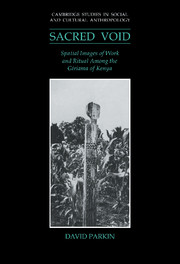Book contents
- Frontmatter
- Contents
- List of illustrations
- Preface
- Introduction
- 1 Fantasies of the west
- 2 Western Kaya, sacred centre
- 3 View from the west: cattle and co-operation
- 4 From west to east: the works of marriage
- 5 Spanning west and east: dances of death
- 6 Alternative authorities: incest and fertility
- 7 Alternative selves: invasions and cures
- 8 Coastal desires and the person as centre
- Conclusion
- Appendix 1 Three ecological zones and demographic features of southern Kilifi District
- Appendix 2 Giriama kinship and affinal terms
- Appendix 3 Giriama cattle terms
- Appendix 4 Giriama patri-clan structure
- Bibliography
- Index
- Cambridge Studies in Social and Cultural Anthropology
3 - View from the west: cattle and co-operation
Published online by Cambridge University Press: 03 November 2009
- Frontmatter
- Contents
- List of illustrations
- Preface
- Introduction
- 1 Fantasies of the west
- 2 Western Kaya, sacred centre
- 3 View from the west: cattle and co-operation
- 4 From west to east: the works of marriage
- 5 Spanning west and east: dances of death
- 6 Alternative authorities: incest and fertility
- 7 Alternative selves: invasions and cures
- 8 Coastal desires and the person as centre
- Conclusion
- Appendix 1 Three ecological zones and demographic features of southern Kilifi District
- Appendix 2 Giriama kinship and affinal terms
- Appendix 3 Giriama cattle terms
- Appendix 4 Giriama patri-clan structure
- Bibliography
- Index
- Cambridge Studies in Social and Cultural Anthropology
Summary
‘A man without cattle is like a man without work’
‘If you are lent cattle, it is like work because you can sell the milk’
Hiding the cattle
Wide-flung co-operation is essential in the vastness of the western and northern hinterland of Giriama country. Although clans may claim to be the holders of specific tracts of land on the basis of first and continuous settlement, uncultivated land is nevertheless available to anyone for livestock grazing. It is when people build a homestead and cultivate land that tensions may develop between them and the clan owners. But, given the greater availability of land and the fact that farming is normally secondary to keeping livestock as a livelihood, such tensions are far fewer than in the heavily populated eastern areas. A second area of co-operation, in addition to the common use of grazing land, is the sophisticated system by which cattle owners place their animals in a number of different herds spread out over a large area.
In fact, this placing of animals provides mutual benefits for cattle owners and herders alike. The Giriama actually call the practice that of ‘hiding cattle’ (ku-fitsa ngombe), refusing to reveal to each other how many they have and so guarding their herds against the demands of agnates and tax assessors.
- Type
- Chapter
- Information
- The Sacred VoidSpatial Images of Work and Ritual among the Giriama of Kenya, pp. 58 - 83Publisher: Cambridge University PressPrint publication year: 1991



